History
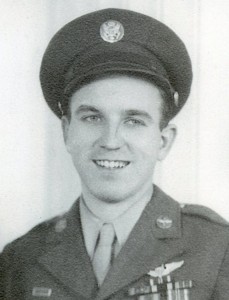 It’s hard for me to think about D-Day, without wondering what things were going through my dad, Allen Spencer’s mind on that day. Each branch of the military had their own part to play and each was in much danger. I suppose it’s possible that the men on the ground were in the most danger, but in reality, anyone who was involved that day faced grave danger. Soldiers could be shot and killed, ships could be sunk, and planes could be shot down. No matter how the attack came, death was often the result, and in battle it was inevitable.
It’s hard for me to think about D-Day, without wondering what things were going through my dad, Allen Spencer’s mind on that day. Each branch of the military had their own part to play and each was in much danger. I suppose it’s possible that the men on the ground were in the most danger, but in reality, anyone who was involved that day faced grave danger. Soldiers could be shot and killed, ships could be sunk, and planes could be shot down. No matter how the attack came, death was often the result, and in battle it was inevitable.
My dad was a young man of just 20 years. That is the age of my two oldest grandchildren, and I simply cannot imagine either of them being in that position. Of course, they could handle it, because twenty year olds have been fighting wars for as long as wars have been fought. It is me, and my mind, that can’t wrap itself around the idea of them being in an airplane providing air support over a battlefield. For my dad, every mission held an adrenalin rush, a degree of excitement, and a large degree of dread, mixed with the need to push back fear. Flying in the B-17G Bomber was an exciting thing for him, but unfortunately it had to 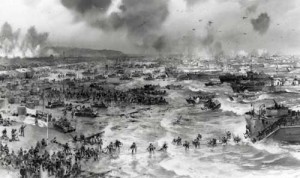 be mixed with the reality of the fact that those bombs were killing people…even if they were the enemy. They often had no say in the matter, they were an enemy of the Allied Forces simply because they lived in the country they did.
be mixed with the reality of the fact that those bombs were killing people…even if they were the enemy. They often had no say in the matter, they were an enemy of the Allied Forces simply because they lived in the country they did.
The air war was vastly different from the ground war, but that didn’t make either more of less dangerous. The Luftwaffe was not widely used on D-Day, but did come racing in over the following days. The weather was bad that first day, and that was definitely to the advantage of the Allied troops. Nevertheless, there were German forces involved, and without air support, they could not have pulled off the victory they did at Normandy. The planes that were there to provide air support, were basically magnets for the 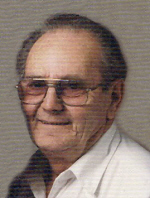 Luftwaffe, and any other enemy forces on the ground. Flying over Normandy was not a task to be taken lightly. Their job was to keep the bombers, tanks, and other soldiers off of the ground troops. The men risked their lives every second that they were in the air. The men on the ground were so vulnerable, and it was imperative that they have good air cover to keep as much enemy fire off of them as possible. It was very clear that without the air support, D-Day would not have been possible.
Luftwaffe, and any other enemy forces on the ground. Flying over Normandy was not a task to be taken lightly. Their job was to keep the bombers, tanks, and other soldiers off of the ground troops. The men risked their lives every second that they were in the air. The men on the ground were so vulnerable, and it was imperative that they have good air cover to keep as much enemy fire off of them as possible. It was very clear that without the air support, D-Day would not have been possible.
I am very proud of the part my dad played in D-Day, as I am of men like my Uncle Jim Wolfe, who was one of those men on the ground on that fateful day. Their job was a very dangerous one, and many of them would not see the sun set that night, but they had a job to do, and so they went out to battle for the freedom of those who were oppressed by the evil that was Hitler. It is a battle we will never forget, nor will we forget the men who fought there, especially those who gave all.
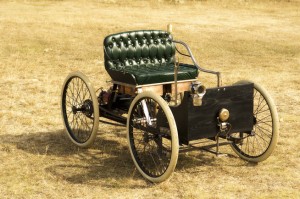 Henry Ford has long been credited for building the first automobile, but what I find interesting and even a little bit funny, is the fact that in reality, that first vehicle, introduced on this day, June 4, 1896, was called a Quadricycle, and in reality was far more like the modern day 4 wheeler ATV than it was an automobile. When we think of an automobile, even the early models, we think of a vehicle with a top over it, or really an automobile body over it. Such was not the case with Ford’s first design. He was more interested in making a vehicle that ran…and ran fast…than in a way to protect the passengers from the elements. I suppose that since people were used to riding in wagons or carriages, having a cover over the Quadricycle wasn’t the most important thing on the wish list. Of course, when it came to capabilities, the Quadricycle was nothing like the modern day ATV, but then the original cars were not capable of going as fast or as far as the modern day automobiles either.
Henry Ford has long been credited for building the first automobile, but what I find interesting and even a little bit funny, is the fact that in reality, that first vehicle, introduced on this day, June 4, 1896, was called a Quadricycle, and in reality was far more like the modern day 4 wheeler ATV than it was an automobile. When we think of an automobile, even the early models, we think of a vehicle with a top over it, or really an automobile body over it. Such was not the case with Ford’s first design. He was more interested in making a vehicle that ran…and ran fast…than in a way to protect the passengers from the elements. I suppose that since people were used to riding in wagons or carriages, having a cover over the Quadricycle wasn’t the most important thing on the wish list. Of course, when it came to capabilities, the Quadricycle was nothing like the modern day ATV, but then the original cars were not capable of going as fast or as far as the modern day automobiles either.
Henry Ford didn’t start out as an inventor, but was actually working as the chief engineer for the main plant of the Edison Illuminating Company when he began working on the Quadricycle. He was on call at all hours, because they had to ensure that Detroit had electrical service 24 hours a day. His flexible schedule gave Ford the freedom needed to experiment with his pet project, which was building a horseless carriage with a gasoline powered engine. Ford had seen an article on the subject gasoline powered motors in a November 1895 issue of American Machinist magazine, and his obsession with the gasoline engine was born. Then, the following March, another Detroit engineer named Charles King introduced his hand built wooden vehicle with a four cylinder engine, beating Ford out by about three months. His vehicle was able to travel up to five miles per hour, fueling Ford’s desire to build a lighter and faster gasoline powered vehicle.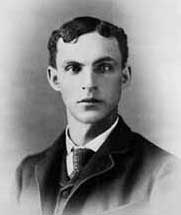
As great as Ford was at building his Quadricycle, which would travel at speeds of about 20 miles per hour, it is doubtful that Ford could have ever been hailed as a great designer of garages. As he and his crew went to push the Quadricycle out of the back yard shed they had built it in, they discovered that it was too wide to fit through the door. Not willing to wait another minute, Ford grabbed an axe, and smashed the brick wall away to allow the Quadricycle to be pushed out. Then as a friend rode his bicycle down the street to warn the people of the vehicle that was to follow, Ford drive his Quadricycle for the first time. I find it odd that while Charles King actually built that first vehicle, he was never really credited with doing so, and Ford went on to build many of them, and as we all know, to become quite famous doing so.
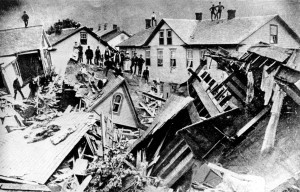 Over the years, man has tried many ways to harness water. Water is a necessity to life, and without it, all things would die off. Some projects worked out better than others, and some simply needed to be replaced sooner than they were in order to prevent disaster. A good example of that is the earthen dam. An earthen dam is a dam that is built out of rocks and dirt, instead of steel and concrete. Of course, when dams were first built, earthen dams were the only way to go, but after so many failed, a new type of dam had to be designed, in order to save lives. One such failure was the earthen dam built in 1840 on the Little Conemaugh River, fourteen miles upstream from Johnstown, Pennsylvania. Johnstown is sixty miles east of Pittsburgh, in a valley near the Allegheny, Little Conemaugh, and Stony Creek Rivers. The area lies in a floodplain that has had frequent disasters. This time would prove to be one of them. At nine hundred by seventy two feet, this dam was the largest earthen dam in the United States, creating the largest man-made lake at that time…Lake Conemaugh. At a time when here were no railroads in the area for transporting goods, the dam and its extensive canal system was the only way to transport goods to the people, but it became obsolete as the railroads replaced the canal as a means of transporting goods. The canal system was left to become a victim of the elements, and with its neglect, also came the neglect of the dam. In reality, people just didn’t really think anything would happen, and they most likely looked at the dam as just a part of the landscape.
Over the years, man has tried many ways to harness water. Water is a necessity to life, and without it, all things would die off. Some projects worked out better than others, and some simply needed to be replaced sooner than they were in order to prevent disaster. A good example of that is the earthen dam. An earthen dam is a dam that is built out of rocks and dirt, instead of steel and concrete. Of course, when dams were first built, earthen dams were the only way to go, but after so many failed, a new type of dam had to be designed, in order to save lives. One such failure was the earthen dam built in 1840 on the Little Conemaugh River, fourteen miles upstream from Johnstown, Pennsylvania. Johnstown is sixty miles east of Pittsburgh, in a valley near the Allegheny, Little Conemaugh, and Stony Creek Rivers. The area lies in a floodplain that has had frequent disasters. This time would prove to be one of them. At nine hundred by seventy two feet, this dam was the largest earthen dam in the United States, creating the largest man-made lake at that time…Lake Conemaugh. At a time when here were no railroads in the area for transporting goods, the dam and its extensive canal system was the only way to transport goods to the people, but it became obsolete as the railroads replaced the canal as a means of transporting goods. The canal system was left to become a victim of the elements, and with its neglect, also came the neglect of the dam. In reality, people just didn’t really think anything would happen, and they most likely looked at the dam as just a part of the landscape.
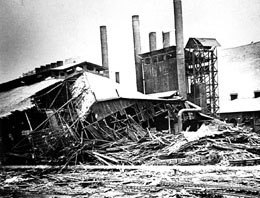
By 1889, Johnstown had grown to a population of 30,000 people, many of whom worked in the steel industry…ironically. On May 30, 1889, it began to rain, and continued steadily all day. No one really gave any thought the potential harm so much rain could bring to the nearly sixty year old earthen dam. The dam had a spillway, and so everything seemed safe, but the spillway became clogged with debris, that could not be dislodged. On May 31, 1889, an engineer at the dam saw the warning signs, but the only way to notify anyone was to ride his horse into the village of South Fork to warn the people…a ride that took an eternity in the face of the impending disaster. Nevertheless, it should have been enough time, but the telegraph lines were down, and no warning ever reached Johnstown. At 3:10pm, the dam collapsed with a roar that could be heard for miles. The water, moving at 40 miles per hour barreled down on the towns in it’s path, wiping out everything that got in its way. At Johnstown, 2,200 people lost their lives that day, including one Thomas Knox and his wife. Thomas, like a large number of the flood victims was never found. While I’m not sure that Thomas Knox is related to my husband, Bob Schulenberg’s family, it is quite likely that he is, as there are a number of Thomas Knox’s in the family…though none that I have found so far that died in the Johnstown Flood.
The people in the path of the raging flood waters, were tossed around, along with all that debris, including thirty three train engines that were pulled into the flood waters. I’m sure that for many, death did not come  from drowning, but rather from blunt force trauma. Nevertheless, some people did manage to climb atop the debris, only to be burned alive when much of the debris caught fire, when it was caught in a bridge downstreem and burst into flames. There was a report of a baby that survived on the floor of a house that floated 75 miles downstream, but that was something that was not confirmed. It was during the Johnstown flood, that the American Red Cross handled its first major relief effort. Clara Barton arrived five days after the flood to lead the relief. In the end, it took five years to rebuild Johnstown, which went through disastrous floods in 1936 and 1977. I have to wonder if they should just move the town, but with no major floods since 1977, it’s hard to say.
from drowning, but rather from blunt force trauma. Nevertheless, some people did manage to climb atop the debris, only to be burned alive when much of the debris caught fire, when it was caught in a bridge downstreem and burst into flames. There was a report of a baby that survived on the floor of a house that floated 75 miles downstream, but that was something that was not confirmed. It was during the Johnstown flood, that the American Red Cross handled its first major relief effort. Clara Barton arrived five days after the flood to lead the relief. In the end, it took five years to rebuild Johnstown, which went through disastrous floods in 1936 and 1977. I have to wonder if they should just move the town, but with no major floods since 1977, it’s hard to say.
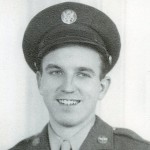 For those who have lost a veteran, in war or in peace, every day is a day to remember them. We loved them and now they are gone. We will forever miss them. Brave soldiers all, went out to right a wrong…to make the sacrifice necessary to make our nation free, and to fight oppression in our world. Some came home after serving their country and somehow managing to stay alive…against all odds, but some did not, and instead paid the ultimate price…their lives. All were brave soldiers, who knew what was being asked of them, knew the possibilities, and yet they went anyway, knowing that when they left home to serve, they might not be returning. They felt a calling to serve, and they bravely answered the call. Without the brave soldiers who have answered that call over
For those who have lost a veteran, in war or in peace, every day is a day to remember them. We loved them and now they are gone. We will forever miss them. Brave soldiers all, went out to right a wrong…to make the sacrifice necessary to make our nation free, and to fight oppression in our world. Some came home after serving their country and somehow managing to stay alive…against all odds, but some did not, and instead paid the ultimate price…their lives. All were brave soldiers, who knew what was being asked of them, knew the possibilities, and yet they went anyway, knowing that when they left home to serve, they might not be returning. They felt a calling to serve, and they bravely answered the call. Without the brave soldiers who have answered that call over 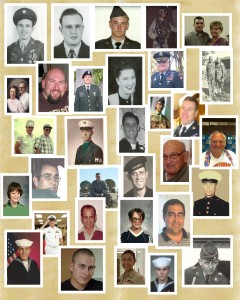 the years, evil would have completely overtaken our world. There is still much evil out there, but it is our prayers and our soldiers that help to keep it at bay.
the years, evil would have completely overtaken our world. There is still much evil out there, but it is our prayers and our soldiers that help to keep it at bay.
I am one of the fortunate ones. My dad and other loved ones came home from their wars. I have never felt the sting of losing a soldier in battle, but I have known those who have, and it breaks my heart for them. Each of them bravely moves forward with their lives, carrying with them the memories of their loved one, lost in battle. Little routines like jewelry with their loved one’s name on it, a decal on their car, or a flag in their yard, remind them of their loved one…somehow keeping them close, even though they are gone. They visit the grave, some to talk to their loved one, others to simply sit and reminisce about the past, but all do the things they do for the same reason…to remember their brave soldier, so tragically lost to the ravages of war.
Whether we have lost someone in battle, or our soldier died after leading a long life, each day that is set aside to remember their service is a special day to us. 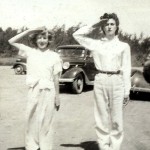 It doesn’t mean that we don’t enjoy the day off or have a barbeque…it just means that we really think about the reasons that we are free to do these things. My own dad loved barbeques, drives to the lake or the mountains, and camping on the long weekends, so why would we not do those things now that he is living in Heaven. Nevertheless, we also take flowers, spinners, wind chimes, and of course, a flag to place on my parents grave, as well as the graves of all our other loved ones. It is a tradition that keeps them in our remembrance, and after all, the most important part of Memorial Day is to remember those we have lost, especially our brave soldiers. So today, we salute all of our soldiers, living and dead. We thank you for your brave service. We will never forget. Happy Memorial Day to all.
It doesn’t mean that we don’t enjoy the day off or have a barbeque…it just means that we really think about the reasons that we are free to do these things. My own dad loved barbeques, drives to the lake or the mountains, and camping on the long weekends, so why would we not do those things now that he is living in Heaven. Nevertheless, we also take flowers, spinners, wind chimes, and of course, a flag to place on my parents grave, as well as the graves of all our other loved ones. It is a tradition that keeps them in our remembrance, and after all, the most important part of Memorial Day is to remember those we have lost, especially our brave soldiers. So today, we salute all of our soldiers, living and dead. We thank you for your brave service. We will never forget. Happy Memorial Day to all.
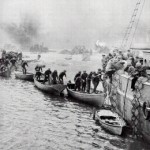 Not many disastrous wartime defeats could be declared a miraculous success, but in May of 1940, with the Germans advancing quickly toward Dunkirk the French, British, and Canadian troops were trapped between the German forces, and the English Channel. This situation was far more that a disastrous defeat, it was about to get catastrophic, because there appeared to be no way to get the Allied troops out of the way of the German forces, and the Allies were looking at the loss of thousands of soldiers, if something wasn’t done…and done quickly!!
Not many disastrous wartime defeats could be declared a miraculous success, but in May of 1940, with the Germans advancing quickly toward Dunkirk the French, British, and Canadian troops were trapped between the German forces, and the English Channel. This situation was far more that a disastrous defeat, it was about to get catastrophic, because there appeared to be no way to get the Allied troops out of the way of the German forces, and the Allies were looking at the loss of thousands of soldiers, if something wasn’t done…and done quickly!!
It was at this point that my 15th cousin 0nce removed, Winston Spencer-Churchill showed the world what a great master strategist he really was. He had warned the Allies that “the whole root, the core, and brain of the British Army” was stranded and likely to die in Dunkirk, if they didn’t come up with a way to evacuate them. A plan was devised, and given the code name, Operation Dynamo. This plan was really a God-given way of escape, where their seemed to be no way. In fact, Churchill 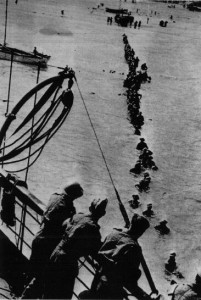 called it “a miracle of deliverance.” And so it was.
called it “a miracle of deliverance.” And so it was.
The plan used every available “ship”…right down to the smallest lifeboat. These vessels…thousands of them, many of which were manned by civilian volunteers, and each of them knew the danger they were putting themselves and their vessels in, but they bravely made the decision to participate anyway. On this day, May 26, 1940, at 19:00 hours, Vice Admiral Ramsey was given the orders and Operation Dynamo commenced. The order was given to proceed, amid information that Boulogne and Calais had been captured. This meant that the only port available was Dunkirk. Ramsey estimated that only 45,000 troops could be rescued. Lord John Galt had ordered the troops to retreat to the sea. As the Belgian army was defeated, King Leopold asked the Germans for an armistice. This dragged out the negotiations, and bought the Allies 24 hours to get their troops out.
The rescue was slow and, in fact took days. The weather prevented the Luftwaffe from attacking for a time, but that didn’t last long. Within a matter of days the weather cleatred and the Germans set out to try to stop the 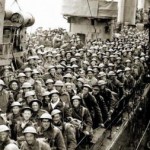 rescue that they had not realized was of the magnitude it was. From their attack, several ships wer sunk, but that still didn’t stop the seccess of the operation. By the time the last boat left Dunkirk harbor, about 338,226 soldiers (198,229 British and 139,997 French) were evacuated by a fleet of 860 boats.
rescue that they had not realized was of the magnitude it was. From their attack, several ships wer sunk, but that still didn’t stop the seccess of the operation. By the time the last boat left Dunkirk harbor, about 338,226 soldiers (198,229 British and 139,997 French) were evacuated by a fleet of 860 boats.
The evacuation was dubbed Operation Dynamo, because during World War One, Dover Castle was powered with electricity by a dynamo located beneath the castle. The castle was used as naval headquarters during World War Two, and the dynamo room is where British Vice-Admiral Bertram Ramsay planned the Dunkirk rescue mission. It is also the place where Ramsay briefed Churchill while rescue efforts were underway.
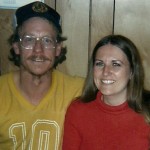 As a teenager, riding the strip in the evenings of the early 1970s, a favorite place to stop was A & W. The food there was great, but the Root Beer Floats were fantastic. In fact, A & W was famous for their Root Beer Floats. My husband, Bob and I used to go there often, and it was a favorite of his little brother Ron’s too. It never occurred to me in those days, just where Root Beer came from, or who invented it. I didn’t really care. I just knew I liked it, and even though I no longer drink pop, I do like an occasional Root Beer Float.
As a teenager, riding the strip in the evenings of the early 1970s, a favorite place to stop was A & W. The food there was great, but the Root Beer Floats were fantastic. In fact, A & W was famous for their Root Beer Floats. My husband, Bob and I used to go there often, and it was a favorite of his little brother Ron’s too. It never occurred to me in those days, just where Root Beer came from, or who invented it. I didn’t really care. I just knew I liked it, and even though I no longer drink pop, I do like an occasional Root Beer Float.
But…where did Root Beer come from? Well, on this day, May 16, 1866, Charles Elmer Hires first came out with an early version of commercially prepared root beer. Hires was a Quaker pharmacist from Philadelphia, Pennsylvania…his version of Root Beer became famous. I’m sure you’ve heard of Hires Root Beer. It was named after Charles Hires, but it was not the Root Beer that I grew up loving. Maybe that is because, as far as I know, A & W Root Beer was the first make a Root Beer Float. Of course, I could be wrong too.
In the days of Hires’ childhood, children were allowed to work, and at age twelve he had a job as a drugstore boy. Then at age sixteen he moved to Philadelphia and worked in a Pharmacy. He saved his money and when he had earned about $400, he started his own drugstore. Things were different then, and that was possible for a young man to do, o he did it. Nevertheless, he had that entrepreneurial spirit, and maybe that is why he was able to come up with something new.
There are those who say that he learned about root beer on his honeymoon in New Jersey, where the woman who ran the hotel served a herb tea known as “root tea” made from assorted roots. It is said that Hires thought  that “root beer” would be more appealing to the working class. He originally packaged the mixture in boxes and sold it to housewives and proprietors of soda fountains. They needed to mix in water, sugar, and yeast. I suppose that after a while that got to be too much work, and eventually it came processed and in bottles. The funny this is that Root Beer was slow to catch on until Reverend Dr Russell Conwell told Hires to present the drink as “the temperance drink” and the greatest health-giving beverage in the world.” Hires was active in the temperance movement, and some say that he wanted root beer to be an alternative to alcohol. I can’t say that he was successful in that respect, because I don’t know anyone who would drink Root Beer instead of beer, unless they already didn’t drink.
that “root beer” would be more appealing to the working class. He originally packaged the mixture in boxes and sold it to housewives and proprietors of soda fountains. They needed to mix in water, sugar, and yeast. I suppose that after a while that got to be too much work, and eventually it came processed and in bottles. The funny this is that Root Beer was slow to catch on until Reverend Dr Russell Conwell told Hires to present the drink as “the temperance drink” and the greatest health-giving beverage in the world.” Hires was active in the temperance movement, and some say that he wanted root beer to be an alternative to alcohol. I can’t say that he was successful in that respect, because I don’t know anyone who would drink Root Beer instead of beer, unless they already didn’t drink.
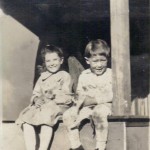 Having your child at work is not a new idea really. Many people have made arrangements with their boss, so that they could bring their little ones to work with them…at least until they are old enough to go to school full time. Sometimes, I think that every mom should be able to bring their baby to work while they are little. Daycare is expensive, and often makes it almost impossible for the mom to work outside the home, because they end up paying more for daycare than they earn…totally not worth it. I didn’t work when my girls were little, but when my daughters had children, they did work. While I didn’t have my grandchildren at my office all day, there were times when they did come to
Having your child at work is not a new idea really. Many people have made arrangements with their boss, so that they could bring their little ones to work with them…at least until they are old enough to go to school full time. Sometimes, I think that every mom should be able to bring their baby to work while they are little. Daycare is expensive, and often makes it almost impossible for the mom to work outside the home, because they end up paying more for daycare than they earn…totally not worth it. I didn’t work when my girls were little, but when my daughters had children, they did work. While I didn’t have my grandchildren at my office all day, there were times when they did come to 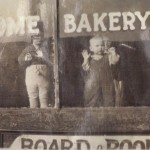 my office…times when they were not feeling well, were the main times. They couldn’t stay home alone, and yet their parents had to work. I was blessed in that I had a boss who allowed me to bring them to the office and let them sleep there. It made all the difference for my daughters.
my office…times when they were not feeling well, were the main times. They couldn’t stay home alone, and yet their parents had to work. I was blessed in that I had a boss who allowed me to bring them to the office and let them sleep there. It made all the difference for my daughters.
Years ago, however, having the kids around was much more common. My grandmother, Anna Schumacher Spencer, ran a hotel when my Aunt Laura and Uncle Bill were little. Of course, the family lived at the hotel, so the kids were always at work 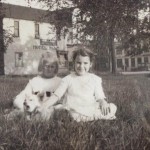 with their mom. Grandpa worked somewhere else, so Grandma was in charge of the hotel. I’m not sure where the bakery came in, but I do know that the patrons of the bakery would not have been surprised to see the little ones in the bakery when they came in to make a purchase. I think that it was common to the times, and maybe something that we all could take a lesson from. Life was about the family. Nothing was more important than that. The parents were involved with the kids, and the family ate their meals together, and spent time together. The parents were role models for the kids, and the television was not the place that they got all of their information. No, it wasn’t perfect, but maybe it was just a little bit more family oriented.
with their mom. Grandpa worked somewhere else, so Grandma was in charge of the hotel. I’m not sure where the bakery came in, but I do know that the patrons of the bakery would not have been surprised to see the little ones in the bakery when they came in to make a purchase. I think that it was common to the times, and maybe something that we all could take a lesson from. Life was about the family. Nothing was more important than that. The parents were involved with the kids, and the family ate their meals together, and spent time together. The parents were role models for the kids, and the television was not the place that they got all of their information. No, it wasn’t perfect, but maybe it was just a little bit more family oriented.
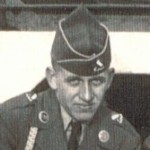 On June 25, 1950, when North Korea invaded South Korea, my uncle, Larry Byer found himself in the middle of what would become some of the hardest years of his life. Uncle Larry was an Army private during the Korean War. Korea was originally under the rule of the Japanese empire, but when it collapsed after World War II, the country was divided. The United Nations, using the United States as its main force, came to aid of South Korea. China, along with assistance from Soviet Union, came to aid of North Korea. North Korea was unhappy with the division of the country that took place after World War II. The global tensions of the Cold War that developed immediately afterwards didn’t help the situation either. Then the North Korean government decided
On June 25, 1950, when North Korea invaded South Korea, my uncle, Larry Byer found himself in the middle of what would become some of the hardest years of his life. Uncle Larry was an Army private during the Korean War. Korea was originally under the rule of the Japanese empire, but when it collapsed after World War II, the country was divided. The United Nations, using the United States as its main force, came to aid of South Korea. China, along with assistance from Soviet Union, came to aid of North Korea. North Korea was unhappy with the division of the country that took place after World War II. The global tensions of the Cold War that developed immediately afterwards didn’t help the situation either. Then the North Korean government decided  to get back the area they believed was actually theirs. In reality, Korea isn’t the only country ever to be divided, so had they simply accepted it, the problem might have been resolved right away, but they simply wouldn’t.
to get back the area they believed was actually theirs. In reality, Korea isn’t the only country ever to be divided, so had they simply accepted it, the problem might have been resolved right away, but they simply wouldn’t.
I understand why something had to be done with the country of Korea, because they had no government, but it doesn’t seem right to me to divide the country. Nevertheless, it was done that way, and in reality, that area has been volatile since that day. North Korea has tried to take over South Korea. They have also made many threats to the rest of the world. Their leader, Kim Jong-il, and now his son, Kim Jong-un, have both proven to be ruthless, and about half crazy. The rest of the world is 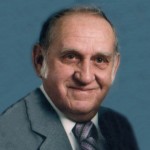 constantly trying to decide if we need to go in an blow them up, or try not to make them too angry. Time will tell, and it depends on Kim Jong-un.
constantly trying to decide if we need to go in an blow them up, or try not to make them too angry. Time will tell, and it depends on Kim Jong-un.
This was the world my Uncle Larry found himself in while he was a private in the Army. The North Koreans fought their battles in any underhanded way they could come up with. Their only goal was to win the war. They didn’t of course, and soon, my Uncle Larry came back home. I’m sure he was very happy to be back home. Spending any time in a crazy war like the Korean war would never be ideal in any way. I am just thankful that he made it home. Today is Uncle Larry’s birthday. He would have been 82 years old. Happy birthday in Heaven Uncle Larry. We love and miss you very much.
 When the United States entered World War II, after the attack on Pearl Harbor, we were a nation with a score to settle. The Japanese had killed our people, and we vowed to make them pay. In addition to that, the Nazis were killing the Jewish people, and they had to be stopped. Their cruel killing of so many people in their gas chambers could not be tolerated. Revenge against the Japanese would have to wait for now, because the Nazi cruelty could no longer be kept hidden.
When the United States entered World War II, after the attack on Pearl Harbor, we were a nation with a score to settle. The Japanese had killed our people, and we vowed to make them pay. In addition to that, the Nazis were killing the Jewish people, and they had to be stopped. Their cruel killing of so many people in their gas chambers could not be tolerated. Revenge against the Japanese would have to wait for now, because the Nazi cruelty could no longer be kept hidden.
On of the biggest battles fought on German soil was the Battle of Berlin. It was fought over the course of a couple of years, and Britain’s Royal Air Force had been badly beaten by the Germans. Then when the United States joined in, things began to take a  turn for the better. On May 7, 1944, the United States 8th Air Force sent 1500 bombers in to attack Berlin. More were sent the next day. The headlines were exuberant. Headlines like Berlin “Condemned to Death”, U.S. Planes Blast Berlin Twice, Capital Lies In Stark Ruins, and Berlin Again Plastered By Yank Fliers, were splattered across the papers. It was the ultimate attack on the heart of Nazi Germany from the Mighty 8th Air Force. I think everyone knew that Hitler’s days in power were numbered. It was true. The Nazis surrendered unconditionally a year later.
turn for the better. On May 7, 1944, the United States 8th Air Force sent 1500 bombers in to attack Berlin. More were sent the next day. The headlines were exuberant. Headlines like Berlin “Condemned to Death”, U.S. Planes Blast Berlin Twice, Capital Lies In Stark Ruins, and Berlin Again Plastered By Yank Fliers, were splattered across the papers. It was the ultimate attack on the heart of Nazi Germany from the Mighty 8th Air Force. I think everyone knew that Hitler’s days in power were numbered. It was true. The Nazis surrendered unconditionally a year later.
My dad was a Top Turret Gunner and Flight Engineer on a B-17G Bomber at this time, and while I don’t know if Dad took part in this attack, I can say that it is entirely possible. My dad didn’t talk about his war days much…most men from that era didn’t. I 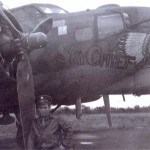 have to think that it was hard to remember those missions, because no matter how distanced you were from your target, you were still very aware that people were dying because of the bombs you were dropping. Sure, they were the enemy, and you were doing your job, but the were also humans. I think, if it were me, I would rather have to kill in the way my dad did…not looking into the eyes of the person you are about to kill, and in some attacks, the people didn’t have any idea that they were about to die. They, like my dad, were just doing their jobs. Still, they were soldiers under a cruel dictator, with no choice but to obey orders. Nevertheless, sad as it was for those people to die, I am very proud of my dad’s service. And if he was in this battle, then I am proud of that too.
have to think that it was hard to remember those missions, because no matter how distanced you were from your target, you were still very aware that people were dying because of the bombs you were dropping. Sure, they were the enemy, and you were doing your job, but the were also humans. I think, if it were me, I would rather have to kill in the way my dad did…not looking into the eyes of the person you are about to kill, and in some attacks, the people didn’t have any idea that they were about to die. They, like my dad, were just doing their jobs. Still, they were soldiers under a cruel dictator, with no choice but to obey orders. Nevertheless, sad as it was for those people to die, I am very proud of my dad’s service. And if he was in this battle, then I am proud of that too.
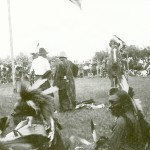 For most of his life in the United States, my great grandfather, Cornelius Byer, was friends with the Indians. He and my grandfather, George Byer were invited to Pow Wows with the Indians, and many of them came to their home bearing gifts and just to visit. That wasn’t the normal course of events in those days, however. For many of the people that the Indians dubbed, The White Man, crossing paths with the Indians meant death. Many of the Indians were considered criminals. They were locked away in prison or, if they were lucky, the reservations. The reservations weren’t great, but they were better than prisons…I suppose.
For most of his life in the United States, my great grandfather, Cornelius Byer, was friends with the Indians. He and my grandfather, George Byer were invited to Pow Wows with the Indians, and many of them came to their home bearing gifts and just to visit. That wasn’t the normal course of events in those days, however. For many of the people that the Indians dubbed, The White Man, crossing paths with the Indians meant death. Many of the Indians were considered criminals. They were locked away in prison or, if they were lucky, the reservations. The reservations weren’t great, but they were better than prisons…I suppose.
Crazy Horse has a serious score to settle with The White Man. The government wasn’t suppose to let the settlers into the Dakotas. Then explorers went in anyway, and found gold. Of course, the government reneged on the deal, and The White Man came flooding into the Dakotas. In reality, it was going to be inevitable. A some point, the United States and her people were going to grow to a place whereby they would need more room. Eventually someone was bound to find the Dakotas, and especially one of my favorite places, The Black Hills. This was the area of the United States where the Lakota Sioux and Crazy Horse lived.
The breaking of the treaty to keep the Dakota Territory in the hands of the Lakota Sioux brought the government into a war with the Lakota Sioux and with Crazy Horse. Crazy Horse would lead the Lakota Sioux to victory in The Battle of the Little Big Horn. After that battle, Crazy Horse was a wanted man, and the cavalry would stop at nothing to find him. After the Battle of the Little Big Horn, on June 25, 1876, it was inevitable that Crazy Horse would one day have to surrender. That day came on May 6, 1877, when Crazy Horse, He Dog, Little Big Man, Iron Crow, and several others surrendered themselves to First Lieutenant William P Clark. For the next four months Crazy Horse resided in his village near the Red Cloud Agency, but Red Cloud and Spotted 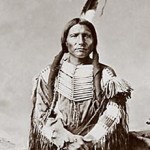 Tail became jealous of the attention the Army gave to Crazy Horse. They had adopted many of the White Man’s ways, and when they heard a rumor that Crazy Horse was planning to slip away, and go back to their old ways. Crazy Horse had actually agreed to fight on the side of the White Man, but his words were misinterpreted, and on the morning of September 4, 1877, just four months after his surrender, the Army attacked Crazy Horse’s village. Crazy Horse agreed to accompany Lieutenant Jesse Lee back to Fort Robinson, there Lieutenant Lee was told to turn him over to the Officer of the Day. He didn’t want to, but he did. As he was taken into custody, Crazy Horse struggles and was stabbed with a bayonet by one of the members of the guard. He died later that night. It was a sad case of misunderstanding, and it cost him his life.
Tail became jealous of the attention the Army gave to Crazy Horse. They had adopted many of the White Man’s ways, and when they heard a rumor that Crazy Horse was planning to slip away, and go back to their old ways. Crazy Horse had actually agreed to fight on the side of the White Man, but his words were misinterpreted, and on the morning of September 4, 1877, just four months after his surrender, the Army attacked Crazy Horse’s village. Crazy Horse agreed to accompany Lieutenant Jesse Lee back to Fort Robinson, there Lieutenant Lee was told to turn him over to the Officer of the Day. He didn’t want to, but he did. As he was taken into custody, Crazy Horse struggles and was stabbed with a bayonet by one of the members of the guard. He died later that night. It was a sad case of misunderstanding, and it cost him his life.

